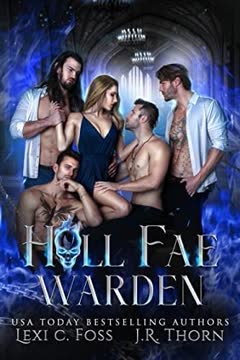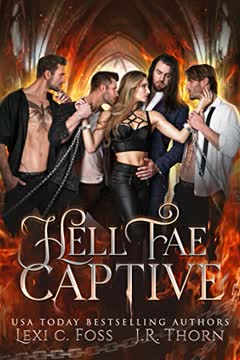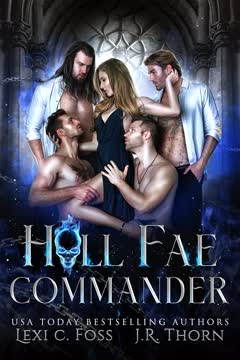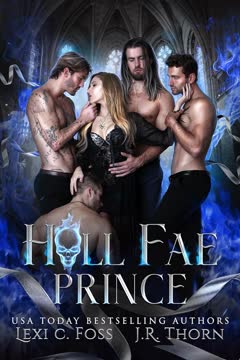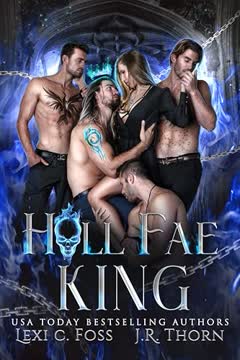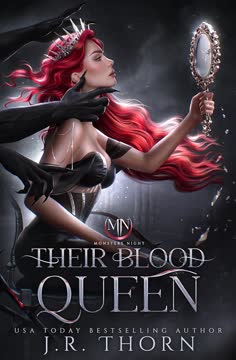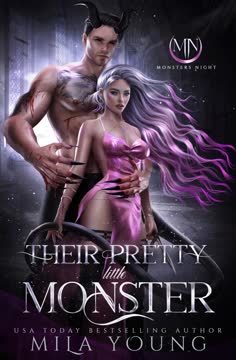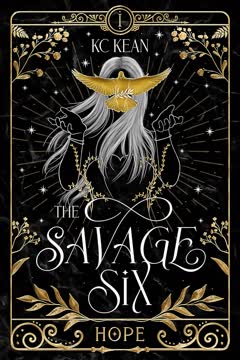Plot Summary
Fallen Angel's Vengeance
The story opens with Typhos Lucifer, once an angel, now the creator and king of the Hell Fae Realm. Betrayed and cast down, he forges a new world for outcasts and abominations, ruling with a mix of vengeance and protection. His power is absolute, but a mysterious breach in his magical source threatens the stability of his realm. Typhos's pain and fury are palpable, and his love for his mate Melek is one of the few things anchoring him. The realm is a patchwork of kingdoms, each home to different fae and monsters, all under Typhos's watchful, wounded gaze. The sense of a world on the edge, ruled by a king who trusts no one, sets the tone for the trials and betrayals to come.
Chains and Choices
Camillia "Cami" De la Croix, a Halfling Hell Fae, wakes naked and bound, interrogated by Azazel (Az) and Ajax, the Warden. She's accused of escaping the deadly Hell Fae Bride Trials for thirty days, though only hours have passed for her. The men's suspicion is laced with desire and violence, and Cami's own feelings are a tangle of attraction and resentment. She's property in a brutal game, but refuses to break, plotting escape even as she's drawn to her captors. The power dynamics are fraught, the sexual tension sharp, and Cami's will to survive is as fierce as her longing for freedom and agency.
The Warden's Dilemma
Ajax, the Warden, is tormented by Cami's escape and his own feelings. He's haunted by a past love, Emelyn, and sees echoes of her in Cami's defiance. His role as enforcer is at odds with his growing desire and guilt. The lines between captor and captive blur as he interrogates Cami, using magical snake vines and truth spells, but finds himself believing her innocence. Ajax's internal conflict—between loyalty to Lucifer, his own pain, and his need for Cami—drives him to the edge, setting up a cycle of punishment, confession, and reluctant intimacy.
The Phoenix's Hunger
Azazel, the Hell Fae Commander, is torn between his duty and the possessive hunger of his inner Black Phoenix. The Phoenix wants to claim Cami, to protect and mark her, while Az the man tries to maintain distance and control. The tension between his animal and human sides is mirrored in his interactions with Cami and Ajax, leading to violence, sexual dominance, and moments of unexpected tenderness. Az's struggle is not just with Cami, but with himself, as he tries to reconcile his beast's instincts with the demands of the Hell Fae King and the chaos in the realm.
Truths and Torments
Cami is subjected to magical truth spells by powerful fae like Zakkai and Zeph, revealing that she truly doesn't know how she escaped or lost thirty days. The truth spells force confessions from all sides, exposing vulnerabilities and hidden desires. Melek, the prince, emerges as a more enigmatic and seductive figure, offering healing and comfort to Cami, and hinting at deeper connections. The web of alliances and betrayals grows more complex, as each character's motives—love, power, survival—are laid bare, and the lines between enemy and lover blur.
The King's Test
Typhos Lucifer, needing to maintain control and punish transgressions, devises a public spectacle to discipline Cami and Ajax for breaking the rules of the trials. Cami is forced into humiliating, enchanted chains and displayed before the Hell Fae court, while Ajax is magically restrained and made to watch. The punishment is both a test and a lesson, designed to reinforce Lucifer's authority and to see how far Cami and Ajax will go for each other. The scene is charged with eroticism, shame, and defiance, and marks a turning point in Cami's relationship to power and pain.
The Prince's Knot
Melek, Lucifer's mate and the realm's prince, reveals his intentions to Cami: he wants her as his own, and perhaps as part of a greater circle with Az and Ajax. He heals her wounds, offers comfort, and seduces her with both words and touch, tying her in symbolic knots that hint at future pleasures and deeper bonds. Melek's games are both literal and metaphorical, as he weaves Cami into the fabric of the realm's power structure, promising her agency and desire if she can survive the king's tests.
The Source's Touch
Cami's ability to read Lucifer's living book, Vita, and her accidental touch of the Hell Fae Source, mark her as something unique and potentially dangerous. The source, a wellspring of power tied to Lucifer's soul, should kill any outsider who touches it, but instead it tests and spares Cami. This connection makes her both a threat and a potential savior, as the realm's stability is shaken by breaches and portals. Cami's struggle to understand her power, and Lucifer's fear of what she represents, drive the narrative toward a reckoning.
The Portal's Breach
A new portal opens in the Marsh Lands, threatening to destroy the kingdom and suck in everything around it. The chaos of the breach forces all the main players—Lucifer, Melek, Az, Ajax, and Cami—into action. Lucifer and Melek try to close the portal with brute force, but only make it worse. Cami, drawn by an instinctive connection to the source and the realm, realizes she may be the only one who can stop the destruction. The stakes are life and death, not just for the main characters, but for the entire Hell Fae world.
The Caged Bride
Cami is caged and displayed before the Hell Fae, forced to endure hours of public scrutiny, sexual torment from her enchanted chains, and the threat of total exposure. Ajax, magically restrained, is forced to watch, reliving past traumas and feeling powerless to help. The scene is a crucible for both characters, testing their limits and their willingness to fight for each other. The breaking point comes when the portal's explosion shatters the cage and throws Cami into the heart of the Marsh Lands, setting up the final confrontation.
The Unseelie Garden
Cami awakens in the Unseelie Garden, surrounded by destruction and the remnants of the bridal trials. She encounters Ajax, Az, and the Unseelie King, Erebus, as well as other brides in peril. The garden, once a place of beauty, is now a war zone, and Cami's instincts drive her to help the injured and resist the urge to flee. The alliances shift again, as former captors become protectors, and the true nature of the threat facing the realm becomes clear.
The Conduit's Power
Realizing that she is a conduit for Lucifer's power, Cami draws on the source, Melek's talisman, and her own will to channel the warmth needed to close the portal. The act is both agony and ecstasy, as she risks her life to save the realm. The experience is transformative, marking her as more than a pawn or a victim—she becomes a force in her own right, capable of shaping the fate of the Hell Fae. The cost is high, and the consequences unknown, but Cami's choice to act cements her place in the story's central circle.
The King's Judgment
With the portal closed and the Marsh Lands in ruins, Lucifer confronts Cami. His anger is tempered by awe and uncertainty—she has done what he could not, but in doing so, she has become both indispensable and dangerous. The balance of power has shifted, and the question of Cami's fate—execution, exile, or elevation—hangs in the air. The emotional arc is one of exhaustion, relief, and dread, as all the characters must reckon with what has been lost and what has been revealed.
The Circle's Fate
The story closes with the main characters—Cami, Ajax, Az, Melek, and Lucifer—bound together by shared trauma, desire, and the need to rebuild. The trials have changed them all, forging new bonds and exposing old wounds. Cami's place in the circle is uncertain, but her power and courage have earned her a seat at the table. The emotional arc is one of hard-won intimacy, the possibility of love, and the looming threat of further trials. The future is uncertain, but the circle is stronger for what they have endured together.
Characters
Camillia "Cami" De la Croix
Cami is a Halfling Hell Fae, sold into the brutal bride trials by her parents. She is fiercely independent, witty, and refuses to be broken by her captors or the system. Her psychological complexity is rooted in trauma, abandonment, and a desperate need for agency. Cami's journey is one of transformation—from captive to conduit, from pawn to power. Her relationships with Ajax, Az, Melek, and even Lucifer are fraught with desire, mistrust, and reluctant intimacy. She is both a victim and a savior, her unique connection to the source making her the key to the realm's survival and the object of everyone's obsession.
Ajax
Ajax is the Hell Fae Warden, tasked with enforcing Lucifer's will and keeping order among the brides. He is tormented by guilt over a lost love, Emelyn, and sees echoes of her in Cami's strength and defiance. His psychological arc is one of self-loathing, duty, and forbidden longing. Ajax's relationship with Cami is a cycle of punishment and confession, as he struggles to reconcile his role as captor with his growing need to protect and possess her. His friendship and rivalry with Az, and his uneasy loyalty to Lucifer, add layers of complexity to his character.
Azazel (Az)
Az is the Hell Fae Commander, a powerful shifter with a Black Phoenix inside him. His internal struggle between the man and the beast is mirrored in his interactions with Cami and Ajax. The Phoenix is possessive, violent, and wants to claim Cami, while Az tries to maintain control and serve Lucifer. His psychological depth comes from this duality, as well as his loyalty to his friends and his king. Az's relationship with Cami is charged with dominance, protection, and a hunger that borders on obsession.
Melek
Melek is Lucifer's mate and the realm's prince, a being of immense power and enigmatic motives. He is both healer and seducer, offering comfort and pleasure to Cami while weaving her into the realm's power structure. Melek's psychological complexity lies in his ability to play all sides, to be both ally and manipulator. His desire for Cami is genuine, but also strategic—he sees her as the missing piece in a circle that could stabilize the realm and anchor Lucifer's growing power. His relationship with Typhos is one of deep love, but also challenge and negotiation.
Typhos Lucifer
Typhos is the creator and ruler of the Hell Fae Realm, a being of immense power, pride, and pain. Betrayed and cast down, he has built a world for outcasts, but rules with an iron fist and a deep mistrust of others. His psychological arc is one of control, fear, and the desperate need to protect what he has built. Lucifer's relationship with Cami is fraught—she is both a threat and a potential savior, and his need to test, punish, and ultimately judge her drives much of the story's conflict. His love for Melek is his anchor, but also a source of vulnerability.
Vita (The Book)
Vita is Lucifer's living book, a sentient artifact that reveals secrets, tests worthiness, and serves as a conduit to the source. It is both a tool and a character, shaping the narrative by what it chooses to reveal or conceal. Vita's connection to Cami marks her as unique, and its role as both guide and trickster adds a layer of magical unpredictability to the story.
Emelyn (in memory)
Emelyn is Ajax's former lover, whose death haunts him and shapes his actions. She represents the pain of loss, the fear of vulnerability, and the possibility of redemption through new love. Her memory is a psychological anchor for Ajax, influencing his relationship with Cami and his willingness to fight for her.
King Erebus
Erebus is the ruler of the Unseelie, a fae of beauty, power, and caprice. His motives are opaque, his allegiance uncertain. He represents the dangers and temptations of the wider fae world, and his interactions with Cami and Ajax add an element of unpredictability to the Marsh Lands trial.
Veronica
Veronica is another bridal candidate, injured and endangered by the chaos of the portal. Her presence highlights the stakes of the trials, the vulnerability of the brides, and the need for solidarity and rescue. She serves as a mirror for Cami's own journey, and her fate is a reminder of what is at risk.
The Black Phoenix
The Phoenix is both a literal and symbolic force, representing the primal hunger, possessiveness, and rage that drive much of the story's erotic and violent energy. Its struggle with Az for control is a metaphor for the battle between instinct and reason, love and domination.
Plot Devices
The Hell Fae Bride Trials
The trials are the central narrative structure, forcing characters into alliances, betrayals, and transformations. They serve as both literal and metaphorical tests—of worthiness, loyalty, and love. The trials are a stage for public punishment, erotic spectacle, and the negotiation of agency and submission. They also provide a backdrop for the exploration of power dynamics, both sexual and political.
Magical Restraints and Enchanted Objects
The use of magical restraints—chains, cages, enchanted clothing—serves as both a plot device and a metaphor for the characters' struggles with power, desire, and autonomy. Vita, the living book, is a catalyst for revelation and change, guiding Cami toward her destiny while also testing her limits.
The Source and Conduit
The Hell Fae Source is both a literal magical force and a symbol of Lucifer's soul and the realm's stability. Cami's accidental touch of the source, and her role as a conduit, drive the central conflict—she is both a threat and a potential savior. The source's reactions to her actions foreshadow the realm's fate and the need for a new balance of power.
Portals and Breaches
The breaches in the realm—portals to other worlds, black holes in the Marsh Lands—serve as both external threats and metaphors for the internal chaos of the characters. They force the main players to confront their fears, test their loyalties, and ultimately come together to save the realm. The portals also provide a narrative structure for escalating tension and the convergence of multiple storylines.
Erotic Power Play
The story uses explicit erotic scenes not just for titillation, but as a means of exploring power, vulnerability, and connection. Sex is a battlefield, a tool for interrogation, a form of punishment, and a path to intimacy. The shifting dynamics of dominance and submission mirror the larger struggles for control and agency in the realm.
Foreshadowing and Mirroring
The narrative is rich with foreshadowing—memories of Emelyn, the living book's visions, the recurring motif of chains and cages—all pointing toward the characters' ultimate fates. The mirroring of past and present, victim and victor, captive and captor, creates a sense of inevitability and transformation.
Analysis
Hell Fae Warden is a story that uses the trappings of dark fantasy and reverse harem romance to interrogate deeper questions of autonomy, trauma, and the possibility of healing through connection. At its core, the book is about what it means to be both a victim and a survivor, to find agency in a world designed to strip it away, and to forge bonds of love and loyalty in the crucible of pain and desire. The narrative structure—built around trials, punishments, and public spectacles—mirrors the psychological journeys of the characters, who must confront their own wounds and the wounds they inflict on others. The use of magical restraints, living books, and portals is not just for world-building, but as metaphors for the ways we are bound by our pasts, our desires, and our fears. The story's explicit eroticism is both a challenge and an invitation—to see sex as a site of negotiation, vulnerability, and, ultimately, transformation. In a modern context, Hell Fae Warden can be read as a meditation on consent, the dangers of unchecked power, and the redemptive potential of chosen family. The lesson is that true strength lies not in domination, but in the willingness to be seen, to be vulnerable, and to fight for one's own agency—even in hell.
Last updated:
Review Summary
Hell Fae Warden received mixed reviews, with an overall rating of 4.33/5. Readers praised the world-building, character development, and steamy scenes. However, some criticized the slow plot progression and repetitive internal dialogue. Many enjoyed Cami's character but felt frustrated with the male leads' treatment of her. Opinions varied on the romance dynamics and pacing. Several reviewers expressed excitement for the next book, while others were unsure about continuing the series. The cliffhanger ending left many readers eager for more.
